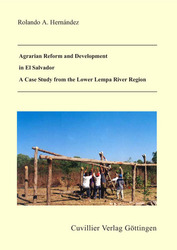| Departments | |
|---|---|
| Book Series (96) |
1378
|
| Nachhaltigkeit |
3
|
| Gesundheitswesen |
1
|
| Humanities |
2363
|
| Natural Sciences |
5406
|
| Mathematics | 229 |
| Informatics | 319 |
| Physics | 980 |
| Chemistry | 1363 |
| Geosciences | 131 |
| Human medicine | 243 |
| Stomatology | 10 |
| Veterinary medicine | 108 |
| Pharmacy | 147 |
| Biology | 835 |
| Biochemistry, molecular biology, gene technology | 121 |
| Biophysics | 25 |
| Domestic and nutritional science | 45 |
| Agricultural science | 1004 |
| Forest science | 201 |
| Horticultural science | 20 |
| Environmental research, ecology and landscape conservation | 148 |
| Engineering |
1791
|
| Common |
98
|
|
Leitlinien Unfallchirurgie
5. Auflage bestellen |
|
Advanced Search
Agrarian Reform and Development in El Salvador (English shop)
A Case Study from the Lower Lempa River Region
Rolando A. Hernández (Author)Preview
Table of Contents, Datei (32 KB)
Extract, Datei (66 KB)
Poverty is pervasive in rural El Salvador. In 2004, the World Bank estimated that 57 percent of the rural population lived in extreme poverty and that 40 percent were illiterate.576 At the core of rural poverty in El Salvador (and throughout Central America) is a highly dualistic and inegaliatrian agrarian structure. This bimodal agrarian structure resulted in the underutilization of both land and labor. The case of El Salvador illustrates the distressing effect that social and economic inequalities in income and wealth distribution might have on furthering outbreaks of social unrest, violent conflict and a push for state-led redistribution of land. It could be argued that a more equal distribution of income and wealth could enhance economic growth and reduce civil conflict not necessarily through the redistribution of land alone but also through the redistribution of other assets such as access to education or other capital goods. When land is so unequally distributed that it permits the attachment of power to the agrarian structure, perhaps the only possible way of enhancing economic growth is to change the pattern of land ownership by redistributing large landholdings. This still might hold true when taking into account the efficiency losses that might arise from passing land to individuals who will initially lack managerial skills and supporting services. In this perspective an agrarian reform could be considered as the opportunity costs of an imminent civil war. In El Salvador major land reforms and dynamic changes in land legislation have taken place during the last three decades. In particular, in 1981 a state-mandated redistribution of land was decreed indented to break the dualistic agrarian ownership. Yet, the costs and benefits of mandated asset redistributions must also be carefully considered. While the agrarian reform of 1981 met many social and political objectives, there is a consensus that some of the social welfare gains were lost through a failure to raise agricultural productivity, rural incomes, reduce poverty and worst of all to stop the civil war.
| ISBN-13 (Printausgabe) | 3865379958 |
| ISBN-13 (Hard Copy) | 9783865379955 |
| ISBN-13 (eBook) | 9783736919952 |
| Language | English |
| Page Number | 324 |
| Edition | 1 |
| Volume | 0 |
| Publication Place | Göttingen |
| Place of Dissertation | Marburg |
| Publication Date | 2006-08-29 |
| General Categorization | Dissertation |
| Departments |
Agricultural science
|








